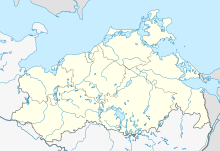Tarnewitzer Huk nature reserve
Coordinates: 53 ° 58 '55 " N , 11 ° 15' 11.7" E


The Tarnewitzer Huk nature reserve is a nature reserve in Mecklenburg-Western Pomerania, northeast of the Boltenhagen district of Tarnewitz. This artificial peninsula separates the Huk the Boltenhagener bay of the well-Wiek .
It was placed under protection on May 21, 1993 at a size of 69 hectares. The aim is to protect an area that was previously used by the military ( Wehrmacht , National People's Army ) and has been subject to succession for 50 years . The nature reserve serves as a research object for unaffected natural development within the framework of so-called process protection .
The nature reserve is classified as an FFH area and bird sanctuary under EU law . A comprehensive management plan to coordinate the interests of nature conservation , water sports and fishing was drawn up in 2006.
The state of the area is considered to be good.
There are no public roads in the area and access is closed due to contaminated sites.
history
The areas of today's protected area were created by extensive flushing in the 1930s in what was then shallow water. A military airfield was created , which was protected from flooding by a 1.5 meter high dike. A port was also built in the southeast of the area. After the end of the Second World War, Soviet forces blew up the airfield and dismantled existing facilities.
Until the Middle Ages, the area belonged to the mainland and established the connection to what was then the Lieps peninsula . Storm floods caused erosion and destroyed the connection.
Flora and fauna
For several decades, the areas have been subject to unrestrained natural development towards large-scale forest cover; only the shooting ranges used until the early 1990s are still free of wood. So far, bush and forest stages have been reached, with sea buckthorn and willow as well as birch and aspen . Areas in the northwestern part are flooded during floods, so that reeds and perennials have settled. The carmine and red backed killer are notable bird species. The natterjack toad lives in the area.
literature
- Tarnewitz Huk 275 . In: Ministry of Environment Mecklenburg-Western Pomerania (Hrsg.): The nature reserves in Mecklenburg-Western Pomerania . Demmler-Verlag, Schwerin 2003, ISBN 3-910150-52-7 , p. 60 f .
- Management plan for the FFH area DE 1934-302 Wismar Bay. (PDF) Ministry of Environment Mecklenburg-Western Pomerania, 2006, p. 132 , accessed on June 12, 2009 .
Web links
- NSG regulation
- Map portal environment of the State Office for the Environment, Nature Conservation and Geology Mecklenburg-Western Pomerania ( information ) with geodata
- Traffic regulations for fishing and water sports ( Memento from July 31, 2009 in the Internet Archive )



